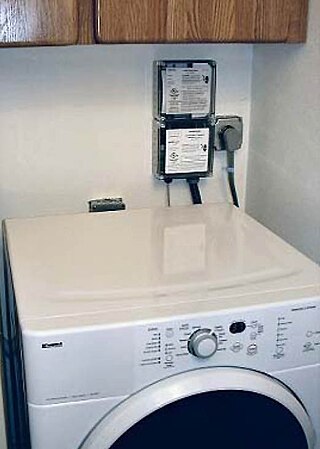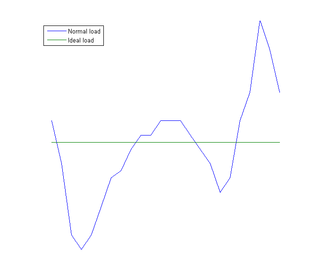
Distributed generation, also distributed energy, on-site generation (OSG), or district/decentralized energy, is electrical generation and storage performed by a variety of small, grid-connected or distribution system-connected devices referred to as distributed energy resources (DER).

Net metering is an electricity billing mechanism that allows consumers who generate some or all of their own electricity to use that electricity anytime, instead of when it is generated. This is particularly important with renewable energy sources like wind and solar, which are non-dispatchable. Monthly net metering allows consumers to use solar power generated during the day at night, or wind from a windy day later in the month. Annual net metering rolls over a net kilowatt-hour (kWh) credit to the following month, allowing solar power that was generated in July to be used in December, or wind power from March in August.

An electricity meter, electric meter, electrical meter, energy meter, or kilowatt-hour meter is a device that measures the amount of electric energy consumed by a residence, a business, or an electrically powered device over a time interval.

A storage heater or heat bank (Australia) is an electrical heater which stores thermal energy during the evening, or at night when electricity is available at lower cost, and releases the heat during the day as required. Alternatively, solar storage heaters are designed to store solar energy as heat, to be released during the night or other periods where it is required, often making it more cost effective than selling surplus electricity to the grid and buying it back at night.
Energy demand management, also known as demand-side management (DSM) or demand-side response (DSR), is the modification of consumer demand for energy through various methods such as financial incentives and behavioral change through education.

Grid energy storage, also known as large-scale energy storage, are technologies connected to the electrical power grid that store energy for later use. These systems help balance supply and demand by storing excess electricity from variable renewables such as solar and inflexible sources like nuclear power, releasing it when needed. They further provide essential grid services, such as helping to restart the grid after a power outage.

Peaking power plants, also known as peaker plants, and occasionally just "peakers", are power plants that generally run only when there is a high demand, known as peak demand, for electricity. Because they supply power only occasionally, the power supplied commands a much higher price per kilowatt hour than base load power. Peak load power plants are dispatched in combination with base load power plants, which supply a dependable and consistent amount of electricity, to meet the minimum demand.

Vehicle-to-grid (V2G) describes a system in which plug-in electric vehicles (PEVs) sell demand response services to the grid. Demand services are either delivering electricity to the grid or reducing the rate of charge from the grid. Demand services reduce the peaks in demand for grid supply, and hence reduce the probability of disruption from load variations. Vehicle-to-load (V2L) and Vehicle-to-vehicle (V2V) are related, but the AC phase is not synchronised with the grid, so the power is only available to "off-grid" load.

Demand response is a change in the power consumption of an electric utility customer to better match the demand for power with the supply. Until the 21st century decrease in the cost of pumped storage and batteries, electric energy could not be easily stored, so utilities have traditionally matched demand and supply by throttling the production rate of their power plants, taking generating units on or off line, or importing power from other utilities. There are limits to what can be achieved on the supply side, because some generating units can take a long time to come up to full power, some units may be very expensive to operate, and demand can at times be greater than the capacity of all the available power plants put together. Demand response, a type of energy demand management, seeks to adjust in real-time the demand for power instead of adjusting the supply.
The Texas electricity market is deregulated, meaning that there is competition in the generation and distribution of electricity. Power generators in the Texas Interconnection, managed by the Electric Reliability Council of Texas, participate in an energy-only electricity market and are compensated only for the electricity they produce. The wholesale generation market was deregulated in 1995 and the distribution market in 1999, with Texas Senate Bill 7. This replaced the prior system in which power was generated and consumed locally by the same utility with one in which retail providers contracted with generators across the state.

Load management, also known as demand-side management (DSM), is the process of balancing the supply of electricity on the network with the electrical load by adjusting or controlling the load rather than the power station output. This can be achieved by direct intervention of the utility in real time, by the use of frequency sensitive relays triggering the circuit breakers, by time clocks, or by using special tariffs to influence consumer behavior. Load management allows utilities to reduce demand for electricity during peak usage times, which can, in turn, reduce costs by eliminating the need for peaking power plants. In addition, some peaking power plants can take more than an hour to bring on-line which makes load management even more critical should a plant go off-line unexpectedly for example. Load management can also help reduce harmful emissions, since peaking plants or backup generators are often dirtier and less efficient than base load power plants. New load-management technologies are constantly under development — both by private industry and public entities.

The smart grid is an enhancement of the 20th century electrical grid, using two-way communications and distributed so-called intelligent devices. Two-way flows of electricity and information could improve the delivery network. Research is mainly focused on three systems of a smart grid – the infrastructure system, the management system, and the protection system. Electronic power conditioning and control of the production and distribution of electricity are important aspects of the smart grid.
A photovoltaic system, also called a PV system or solar power system, is an electric power system designed to supply usable solar power by means of photovoltaics. It consists of an arrangement of several components, including solar panels to absorb and convert sunlight into electricity, a solar inverter to convert the output from direct to alternating current, as well as mounting, cabling, and other electrical accessories to set up a working system. Many utility-scale PV systems use tracking systems that follow the sun's daily path across the sky to generate more electricity than fixed-mounted systems.

Electricity pricing can vary widely by country or by locality within a country. Electricity prices are dependent on many factors, such as the price of power generation, government taxes or subsidies, CO
2 taxes, local weather patterns, transmission and distribution infrastructure, and multi-tiered industry regulation. The pricing or tariffs can also differ depending on the customer-base, typically by residential, commercial, and industrial connections.

An electrical grid is an interconnected network for electricity delivery from producers to consumers. Electrical grids consist of power stations, electrical substations to step voltage up or down, electric power transmission to carry power over long distances, and finally electric power distribution to customers. In that last step, voltage is stepped down again to the required service voltage. Power stations are typically built close to energy sources and far from densely populated areas. Electrical grids vary in size and can cover whole countries or continents. From small to large there are microgrids, wide area synchronous grids, and super grids. The combined transmission and distribution network is part of electricity delivery, known as the power grid.
The United States has the second largest electricity sector in the world, with 4,178 Terawatt-hours of generation in 2023. In 2023 the industry earned $491b in revenue at an average price of $0.127/kWh.

Variable renewable energy (VRE) or intermittent renewable energy sources (IRES) are renewable energy sources that are not dispatchable due to their fluctuating nature, such as wind power and solar power, as opposed to controllable renewable energy sources, such as dammed hydroelectricity or bioenergy, or relatively constant sources, such as geothermal power.

The electricity sector in Taiwan ranges from generation, transmission, distribution and sales of electricity, covering Taiwan island and its offshore islands.

Home energy storage devices store electricity locally, for later consumption. Usually, energy is stored in lithium-ion batteries, controlled by intelligent software to handle charging and discharging cycles. Companies are also developing smaller flow battery technology for home use. As a local energy storage technologies for home use, they are smaller relatives of battery-based grid energy storage and support the concept of distributed generation. When paired with on-site generation, they can virtually eliminate blackouts in an off-the-grid lifestyle.

Smart charging refers to a charging system where electric vehicles, charging stations and charging operators share data connections. Through smart charging, the charging stations may monitor, manage, and restrict the use of charging devices to optimize energy consumption. Comparing with uncontrolled charging, smart charging will flatten the electricity usage peak by shifting the peak due to vehicle charging away from the peak due to other consumption.

















